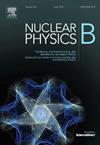探索MATHUSLA隐藏的山谷
IF 2.8
3区 物理与天体物理
Q2 PHYSICS, PARTICLES & FIELDS
引用次数: 0
摘要
隐谷模型自然地预测了许多长寿命的粒子,它们的独特特征将成为隐谷情景的有力证据。由于这些都是典型的低能粒子,它们在大型强子对撞机的传统搜索中对通过能量触发器提出了挑战。MATHUSLA(超大质量定时超稳定中性粒子反射镜)实验是专门为探测长寿命粒子而设计的。它还具有探测相对于ATLAS和CMS的低能量粒子的能力。在本文中,我们评估了MATHUSLA有效探测隐谷模型的潜力。作为基准,我们假设隐谷扇区通过与标准模型夸克和隐谷夸克耦合的重矢量传播子与标准模型扇区通信。我们用PYTHIA模型模拟了隐谷扇区的阵雨和强子化,并研究了探测器接受度作为隐谷介子寿命的函数。我们发现MATHUSLA具有在隐谷模型中探索以前未知参数空间的显著能力。本文章由计算机程序翻译,如有差异,请以英文原文为准。
Exploring the hidden valley at MATHUSLA
Hidden valley models naturally predict numerous long-lived particles, the distinctive signatures of which would be compelling evidence for a hidden valley scenario. As these are typically low-energy particles, they pose a challenge in terms of passing energy triggers in traditional searches at the Large Hadron Collider. The MATHUSLA (MAssive Timing Hodoscope for Ultra-Stable neutraL pArticles) experiment is specifically designed for the purpose of detecting long-lived particles. It also has the capability of detecting lower energy particles relative to ATLAS and CMS. In this paper, we assess MATHUSLA's potential for effectively probing hidden valley models. As a benchmark, we assume the hidden valley sector communicates with Standard Model sectors via a heavy vector propagator that couples to Standard Model quarks as well as hidden valley quarks. We model the showering and hadronization in the hidden valley sector using PYTHIA and study the detector acceptance as a function of the hidden valley meson's lifetime. We find that MATHUSLA possesses significant capabilities to explore previously uncharted parameter space within hidden valley models.
求助全文
通过发布文献求助,成功后即可免费获取论文全文。
去求助
来源期刊

Nuclear Physics B
物理-物理:粒子与场物理
CiteScore
5.50
自引率
7.10%
发文量
302
审稿时长
1 months
期刊介绍:
Nuclear Physics B focuses on the domain of high energy physics, quantum field theory, statistical systems, and mathematical physics, and includes four main sections: high energy physics - phenomenology, high energy physics - theory, high energy physics - experiment, and quantum field theory, statistical systems, and mathematical physics. The emphasis is on original research papers (Frontiers Articles or Full Length Articles), but Review Articles are also welcome.
 求助内容:
求助内容: 应助结果提醒方式:
应助结果提醒方式:


